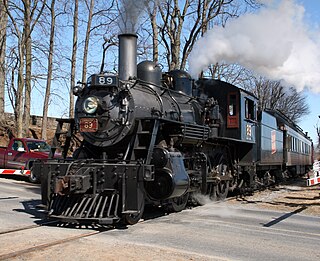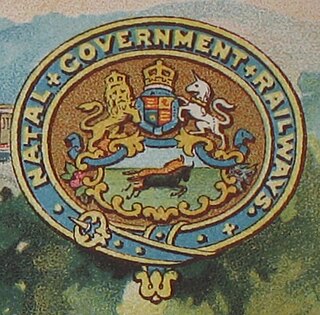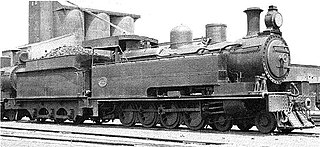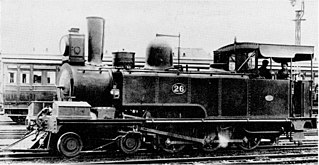
Under the Whyte notation for the classification of steam locomotives, 0-4-0 represents one of the simplest possible types, that with two axles and four coupled wheels, all of which are driven. The wheels on the earliest four-coupled locomotives were connected by a single gear wheel, but from 1825 the wheels were usually connected with coupling rods to form a single driven set.

Under the Whyte notation for the classification of steam locomotives, 2-6-0 represents the wheel arrangement of two leading wheels on one axle, usually in a leading truck, six powered and coupled driving wheels on three axles and no trailing wheels. This arrangement is commonly called a Mogul.

The Natal Government Railways (NGR) was formed in January 1877 in the Colony of Natal.

The South African Railways Class 17 4-8-0TT of 1926 was a steam locomotive from the pre-Union era in the Natal Colony.

The South African Railways Class A 4-8-2T of 1888 is a steam locomotive class from the pre-Union era in the Colony of Natal.

The South African Railways Class H 4-10-2T, introduced in 1899, was a steam locomotive from the pre-Union era in the Colony of Natal.

The South African Railways Class H2 4-8-2T of 1909 was a steam locomotive from the pre-Union era in the Colony of Natal.

The Natal Railway 0-4-0WTNatal of 1858 was a South African steam locomotive from the pre-Union era in the Natal Colony.

The Natal Railway Company was formed in January 1858 for the construction of a 3 kilometres (1.9 mi) railway in Durban.
The South African Railways Class 1 4-8-0 of 1904 was a steam locomotive from the pre-Union era in the Colony of Natal.

The South African Railways Class C 4-6-0T of 1879 was a steam locomotive from the pre-Union era in the Colony of Natal.

The South African Railways Class C1 4-6-2T of 1901 was a steam locomotive from the pre-Union era in the Natal Colony.

The South African Railways Class E 4-6-4T of 1902 was a steam locomotive from the pre-Union era in the Colony of Natal.

The South African Railways Class G 4-8-2T of 1904 was a steam locomotive from the pre-Union era in the Colony of Natal.

The Natal Railway 0-4-0STDurban of 1865 was a South African steam locomotive from the pre-Union era in the Natal Colony.

The Natal Government Railways 2-6-0TDurban and Pietermaritzburg of 1877 were two South African steam locomotives from the pre-Union era in the Colony of Natal.

The Natal Government Railways Class K 2-6-0T of 1877 was a South African steam locomotive from the pre-Union era in the Natal Colony.

The Natal Government Railways Class K 0-6-0ST of 1880 was a South African steam locomotive from the pre-Union era in the Colony of Natal.

The Natal Government Railways Class K 0-4-0ST of 1891 was a South African steam locomotive from the pre-Union era in the Colony of Natal.

South African steam locomotive tenders were classified by means of type letters and sometimes numbers, while locomotive specifications included a list of permissible tenders which could be used with each engine class.




















